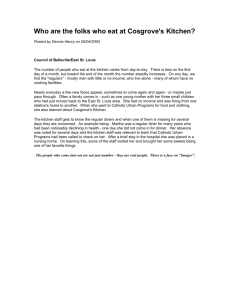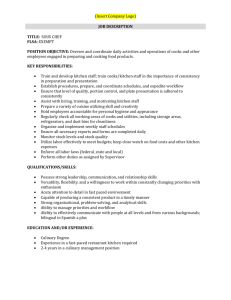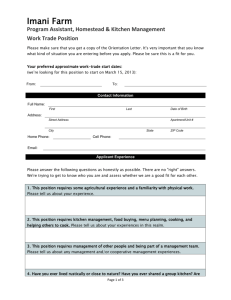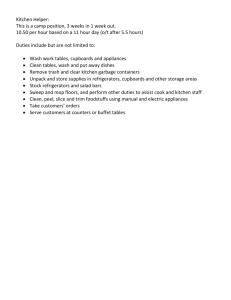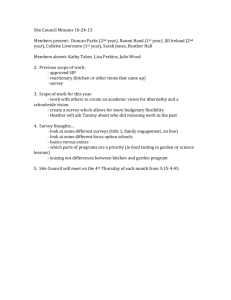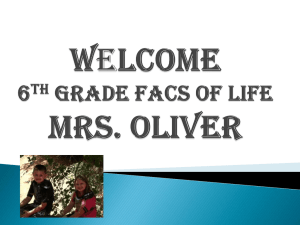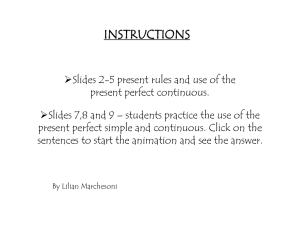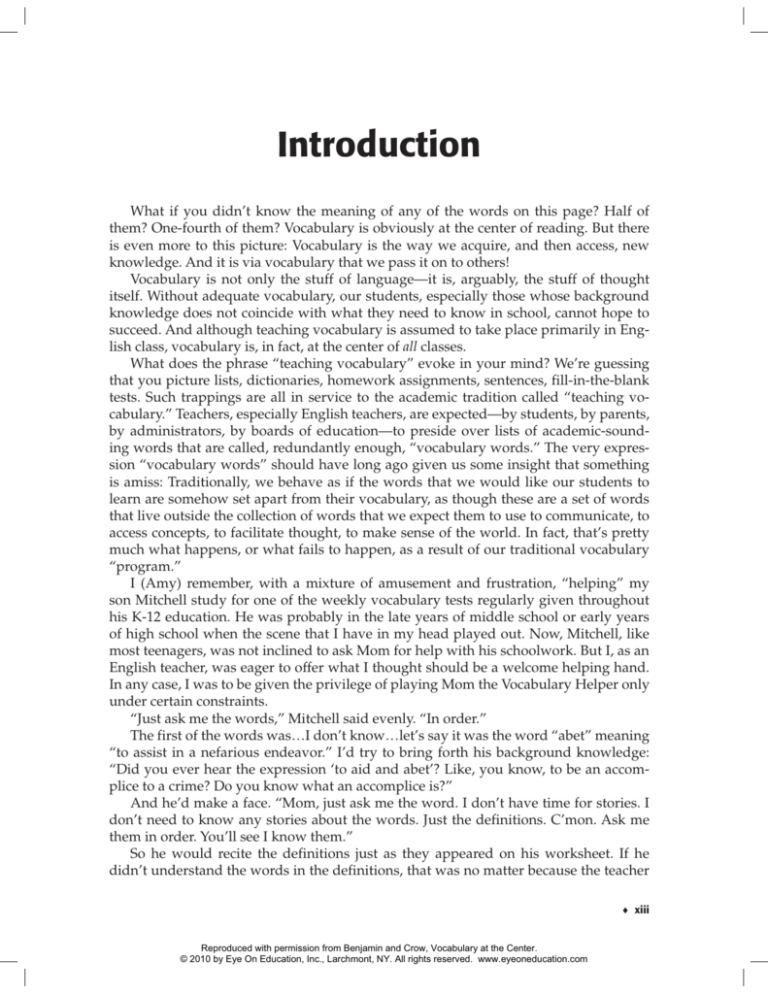
Introduction
What if you didn’t know the meaning of any of the words on this page? Half of
them? One-fourth of them? Vocabulary is obviously at the center of reading. But there
is even more to this picture: Vocabulary is the way we acquire, and then access, new
knowledge. And it is via vocabulary that we pass it on to others!
Vocabulary is not only the stuff of language—it is, arguably, the stuff of thought
itself. Without adequate vocabulary, our students, especially those whose background
knowledge does not coincide with what they need to know in school, cannot hope to
succeed. And although teaching vocabulary is assumed to take place primarily in English class, vocabulary is, in fact, at the center of all classes.
What does the phrase “teaching vocabulary” evoke in your mind? We’re guessing
that you picture lists, dictionaries, homework assignments, sentences, fill-in-the-blank
tests. Such trappings are all in service to the academic tradition called “teaching vocabulary.” Teachers, especially English teachers, are expected—by students, by parents,
by administrators, by boards of education—to preside over lists of academic-sounding words that are called, redundantly enough, “vocabulary words.” The very expression “vocabulary words” should have long ago given us some insight that something
is amiss: Traditionally, we behave as if the words that we would like our students to
learn are somehow set apart from their vocabulary, as though these are a set of words
that live outside the collection of words that we expect them to use to communicate, to
access concepts, to facilitate thought, to make sense of the world. In fact, that’s pretty
much what happens, or what fails to happen, as a result of our traditional vocabulary
“program.”
I (Amy) remember, with a mixture of amusement and frustration, “helping” my
son Mitchell study for one of the weekly vocabulary tests regularly given throughout
his K-12 education. He was probably in the late years of middle school or early years
of high school when the scene that I have in my head played out. Now, Mitchell, like
most teenagers, was not inclined to ask Mom for help with his schoolwork. But I, as an
English teacher, was eager to offer what I thought should be a welcome helping hand.
In any case, I was to be given the privilege of playing Mom the Vocabulary Helper only
under certain constraints.
“Just ask me the words,” Mitchell said evenly. “In order.”
The first of the words was…I don’t know…let’s say it was the word “abet” meaning
“to assist in a nefarious endeavor.” I’d try to bring forth his background knowledge:
“Did you ever hear the expression ‘to aid and abet’? Like, you know, to be an accomplice to a crime? Do you know what an accomplice is?”
And he’d make a face. “Mom, just ask me the word. I don’t have time for stories. I
don’t need to know any stories about the words. Just the definitions. C’mon. Ask me
them in order. You’ll see I know them.”
So he would recite the definitions just as they appeared on his worksheet. If he
didn’t understand the words in the definitions, that was no matter because the teacher
! xiii
Reproduced with permission from Benjamin and Crow, Vocabulary at the Center.
© 2010 by Eye On Education, Inc., Larchmont, NY. All rights reserved. www.eyeoneducation.com
had promised not to pull any fast ones by changing the canned definitions on the Friday
test. If he didn’t know how the word fit into his schema, how it morphed into its various forms, how its connotation differed from its denotation, its synonyms, antonyms,
nuances, that was none of his concern. I played along, grateful, in my motherly way, for
the chance to spend a bit of quality time with this teenager who appeared to be needing
me less and less as he relentlessly grew up.
When Mitchell came home from school after that particular test, on a Friday (of
course), I asked him how he thought he had done. “It was easy,” he said. And when he
got his grade of 100 percent, or close to it, he was vindicated. “I told you I knew how to
study.”
I don’t think that my son is too much different from the way my own students were
in the early years of my teaching career when I used commercial vocabulary programs.
As a young teacher, I didn’t feel confident enough to step out from the paradigm: Give
the students a list of “vocabulary words.” The list often consisted of words plucked
from assigned literature because, so it went, how can they comprehend The Raven unless they look up every word in it that they don’t know? Often, the list was a weekly
parade of unrelated words set forth in a workbook. It was a convenient, well-organized
system, with students being introduced to this week’s hit parade on Monday and then
doing fill-in exercises for homework during the week. We’d visit the words at one or
two points in the subsequent days of the week, perhaps “going over” the homework or
grabbing a few minutes here and there to romance a matching column or “using them
in a sentence.” And on Friday, the test. Every few weeks, there’d be a “cumulative test.”
That’s how it went and no one complained. The students did well, just as Mitchell
had done well, on the commercially prepared tests. They and their parents were happy.
Their vocabulary grades tended to “pull up” their composition and reading comprehension grades, and the words that they “learned” were certainly outside the scope of
their conversational vocabulary. Why would anyone seek to improve or change such a
time-honored, well-controlled system? Who could find fault with it?
Well, as you might imagine, we do. We do find fault, and plenty of it, with the vocabulary pedagogy described above. As you’ve probably noticed, traditional vocabulary
instruction leads to rote memorization but not true vocabulary growth. True vocabulary
growth—where students understand and use the words that they’ve learned—requires
two experiences that traditional workbook-like vocabulary instruction does not provide. These two experiences are (a) extensive processing of the word’s meaning and use
and (b) generous opportunities to use new words for meaningful communication. Add
to this recipe the teacher’s understanding about natural language acquisition, and you
will have students whose vocabulary actually grows, rather than students who have
memorized a bunch of words for a test, only to forget them as soon as the test is over.
We wrote this book to help teachers integrate vocabulary instruction with the language arts so that students could not only expand the scope of their vocabulary, but
could develop their skills as lifelong learners of words and indulge their own innate joy
about language. We believe that vocabulary learning needs to be both robust and gradual: By robust, we mean that vocabulary should have a much bigger place in the language arts class than just the weekly word list, and the learning of one word should lead
xiv ! Vocabulary at the Center
Reproduced with permission from Benjamin and Crow, Vocabulary at the Center.
© 2010 by Eye On Education, Inc., Larchmont, NY. All rights reserved. www.eyeoneducation.com
to deeper understandings of related words. By gradual, we mean that the full meaning
of a word, especially a complex word, should cover more territory than a sterile definition can convey. For many interesting words, meaning is gradually revealed through
repeated exposure in various contexts. We also believe that words, once learned, need to
stay learned. That means that our vocabulary instruction must be cumulative and recursive: we need to nurture new words by using them ourselves and by setting up learning
experiences that will have students using new words, revisiting not-so-new ones.
The chapters of this book fully develop the robust, gradual, cumulative, and recursive approach that we advocate. Each chapter is a combination of brain-based background/theoretical discussion and specific classroom applications that allow you to incorporate the concepts directly into your lesson plans. A chapter-by-chapter breakdown
is given in the following User’s Guide.
Introduction !" xv
Reproduced with permission from Benjamin and Crow, Vocabulary at the Center.
© 2010 by Eye On Education, Inc., Larchmont, NY. All rights reserved. www.eyeoneducation.com
1
Vocabulary at the Center
There is a lot that we don’t know about the inner workings of the brain, but one
thing is certain: vocabulary is central to its conscious operation.
Gateways
Our brains are phenomenal machines—complex, interactive, and powerful, capable of feats that computer scientists can only dream of at the moment. Our brains are
constantly bombarded by input from our senses, and from this information we form
memories. Some are soon forgotten; others are stored in long-term memory, a process
that, incidentally, occurs while we are asleep. However, memories are not stored as selfcontained packets. Instead, as Sousa (2001, p. 50) notes, “Different parts of a memory
are stored in various sites which reassemble when the memory is recalled.” While recall
can certainly be triggered by a smell, an image, a taste, etc., the primary key to recalling
stored data is vocabulary. Hearing or reading a word or phrase allows you to access an
incredible amount of information that you have stored about the targeted phenomenon.
To illustrate, think for a minute about kitchen. Just from seeing this word, you are
able to easily recount the following:
! What a typical one contains.
! What yours looks like: the location of the appliances, the placement and
color of the cabinets, the floor covering, etc.
! The last thing that was prepared in it.
! Where cups, dishes, silverware, etc. are stored in it.
! What your kitchen smells like when your favorite dish is being prepared.
! The dangers inherent in a kitchen.
! What your parents’ kitchen looked like.
! Good or bad things that have happened to you in a kitchen.
This list could go on and on. Again, what serves as a gateway, as an entry point to this
amazingly large body of knowledge? The single word kitchen. And, of course, this is
just one of tens of thousands of concepts that you have stored, each of which interconnects into a vast collection of information that is scattered throughout your brain.
Robert Marzano, author of Building Background Knowledge for Academic Achievement
(2004), defines a word as “…the label associated with a packet of knowledge stored in
permanent memory” (p. 32). These packets of knowledge are what he refers to as back! 1
Reproduced with permission from Benjamin and Crow, Vocabulary at the Center.
© 2010 by Eye On Education, Inc., Larchmont, NY. All rights reserved. www.eyeoneducation.com
ground knowledge. Richard Anderson called each collection of knowledge a schema
(plural schemata). Every English-speaking person has a kitchen schema, for example.
Every person’s kitchen schema certainly will not contain the same details: there will be
cultural differences, experiential differences, socioeconomic differences, and so forth.
But the mere mention of the word kitchen allows each person to access his or her kitchen
schema instantly. Words trigger schemata, opening doors to all kinds of stored knowledge.
Now imagine what it would be like if we humans had not developed language. We
could still have the same brains, brains that were capable of learning from experience.
So we could still store all of the same information about kitchen, but we would have no
easy way to access this information. Without the organizing principle of vocabulary, all
of the facts and experiences that we accumulated across time concerning kitchen would
be randomly scattered across our brains as they occurred and, as a result, be rendered
almost inaccessible. Obviously, the ability to communicate is certainly a very powerful
advantage that language provides us humans. However, the ability to organize and access stored information is, perhaps, equally as important as the ability to communicate
this information. And, again, central to this organization and access is vocabulary.
All of your students know what a kitchen is. They know the word kitchen not only
because they’ve heard it countless times, but also because of their experiences. And
they’ve had reason to use the word kitchen. Now think about a word that might appear
on one of your vocabulary lists, or in a poem, or a novel, or a historical document, or
a newspaper editorial—a word that your students would not know. When they hear
or read such a word, nothing is triggered: no images, no familiar experiences, no cavalcade of other words associated with it. Without the ability to access the background
knowledge that might be associated with this word, your students’ ability to interact
with the content and to interrelate it with existing information—without this gateway
to previous experiences, comprehension begins to grind to a halt. If too many gateways
are blocked, comprehension stops completely.
For example, what if someone came up to you and asked, “How are transposons
remethylated during epigenetic reprogramming?” If you share a background similar to
ours, namely, a very limited exposure to microbiology, this question would not provide
a gateway to a single schema, to the slightest bit of background knowledge. Vocabulary
is at the center of our ability to communicate or to absorb new knowledge.
Vocabulary and Education
Research shows over and over that vocabulary skills correlate very highly with academic ability:
! Intelligence: Anderson and Freebody note that “the strong relationship between vocabulary and general intelligence is one of the most robust findings in the history of intelligence testing” (quoted in Marzano, 2004, p. 32).
Vocabulary scores correlate more highly with intelligence levels than any
other individual measure. That’s why standardized tests such as the SAT,
ACT, and GRE have a vocabulary component.
2 ! Vocabulary at the Center
Reproduced with permission from Benjamin and Crow, Vocabulary at the Center.
© 2010 by Eye On Education, Inc., Larchmont, NY. All rights reserved. www.eyeoneducation.com
! Reading: Farley and Elmore studied college students enrolled in remedial
reading. They found that vocabulary was the only statistically significant predictor of various reading skills. According to Fisher and Frey (2008), research
confirms that “…students with smaller vocabularies and lower comprehension levels read with more trepidation, question the text less, and fail to
notice when they don’t understand something” (p. 4).
! Predictor of Academic Success: Reading comprehension has been repeatedly shown to be a good predictor of academic success at the high school and
college levels. So the chain is complete: vocabulary is an excellent predictor
of reading ability, and reading ability is an excellent predictor of academic
success. Vocabulary truly is at the center—not only of the ELA classroom,
but in all of the content areas.
Definitions Are Not Enough
Research has consistently shown that definitional information alone does not make
a significant contribution to reading comprehension. In a foundational article that synthesizes vocabulary instruction research, Baumann and Kameenui cite several studies
that support the following statement: Having students learn nothing more than words
and their definitions does not significantly improve reading comprehension of texts
that contain the targeted words. So preparing students for a reading passage by having them memorize words + definitions that the passage contains is of very limited
value. Words are not directly linked to their definitions in one’s brain. They are, instead,
gateways to richly interconnected information that a word holds. If that’s the way that
words are stored in one’s brain, doesn’t it make sense that that’s the way we should be
teaching them?
It’s not that we shouldn’t be teaching definitions. Of course, a definition illuminates
a word’s meaning. What we’re saying is that teaching the definition alone—matching a
word to a corresponding synonym or phrase that crystallizes its meaning—is not sufficient information. In the next chapter, you’ll discover more about what it actually means
to know a word.
Vocabulary at the Center
Catherine Snow, Harvard professor and researcher on adolescent literacy and author of Preparing Our Teachers: Opportunities for Better Reading Instruction, is a strong advocate for vocabulary development as a key means for strengthening academic success.
She stresses the importance of ongoing, persistent efforts at vocabulary development
at all grade levels. Snow, whose research team made detailed observations about the
achievement gap in Boston schools in the early 2000s, exposes the differences in vocabulary knowledge between “middle-class kids with well-educated parents” and “kids of
undereducated parents who don’t talk to them very much” (Vaishnav, 2009). The disadvantaged children’s vocabulary was estimated at around 4,000 words in the third grade.
The more advantaged children had a vocabulary of 12,000 words. Snow concludes that
Vocabulary at the Center !" 3
Reproduced with permission from Benjamin and Crow, Vocabulary at the Center.
© 2010 by Eye On Education, Inc., Larchmont, NY. All rights reserved. www.eyeoneducation.com
organized efforts to increase children’s vocabulary in school as early as possible is the
best way to shrink the achievement gap.
The outlook for students having a vocabulary deficit in the early grades is dismal
because as they progress up the grades, two things happen to work against them:
1. They encounter an increasing number of unknown words in content area
text. Lacking vocabulary to begin with, they cannot use context clues.
2. Decreasingly explicit vocabulary instruction is provided.
Vocabulary, then, is to academic learning what cardiovascular strength is to fitness.
And just as most people have to go out of their way to achieve cardiovascular fitness by
working out (rather than relying on their ordinary activities to build sufficient strength),
educators have to be deliberate and conscious about improving students’ vocabulary.
Vocabulary development has to take its place at the center of the curriculum because it
is foundational to all academic achievement.
Not Just for English Class
Vocabulary instruction is everybody’s business. In all subject areas, students need to
learn a specialized language: the language of mathematics, the language of science, the
language of music, and so on. In addition to the specialized terminology that might be
found in the glossary of a subject area textbook, we have a general level of language for
academic conversation. Here’s a sampling of the kinds of language students hear and
read in high school on a typical day:
A square root of a nonnegative number N is one of two equal numbers whose product
is N.
Our sales forecast for the next quarter will form the basis for our financial plans for the
remainder of the current fiscal year. From the sales forecast we will develop production
plans.
Videodisks, also called optical disks, make possible all kinds of new applications because of their storage capacity.
Molten rock, called magma, solidifies deep within the Earth. The final rock type is
determined by the chemical composition of the magma and the rate at which it cooled.
The actors in this dreadful tragedy were a party of soldiers commanded by Captain
Preston of the 29th regiment. This party, including the captain, consisted of eight, who
are all committed to jail.
Verbs tell what a subject does, has, or is. The verb resides in the predicate, along with
the modifiers of the verb, if there are any.
How many of the words in these sentences would stump your students? How helpful is the context? How many words have subject-specific meanings? How many words
represent abstract qualities for which your students may have no concrete association?
If words unlock known information, how much of that information remains locked
4 ! Vocabulary at the Center
Reproduced with permission from Benjamin and Crow, Vocabulary at the Center.
© 2010 by Eye On Education, Inc., Larchmont, NY. All rights reserved. www.eyeoneducation.com
when the students read these sentences in academic text? Yet, while all of this unfamiliar vocabulary is paraded across the students’ eyes, it’s very likely that no coordination
of vocabulary is going on from class to class. Opportunities to have students make connections are missed.
In Active Literacy Across the Curriculum: Strategies for Reading, Writing, Speaking and
Listening (2006), Heidi Hayes Jacobs says:
We should be pumping our students full of words. Although teachers engage in the
well-established practice of giving out vocabulary lists of words developed by English teachers for students to look up and define and use in a sentence, these words are
often de-contextualized or simply lifted from ongoing literature studies. What is rare
is for the words to actually be used especially in a natural context, outside of a discussion about a particular work of literature. Providing a list of enriched words that
make sense for application in any given unit, posting them with the highest visibility,
and then requiring their usage in assignments are key to improving student success
across the curriculum. (p. 34)
To get there, we need to make academic words readily available, that is, visible. A
good way to do this is to provide word walls and word banks. A word wall is simply a
classroom display of key words. Here are some ways to use word walls:
1. Permanent word walls are lists of words that are staples in academic life,
but that students don’t ordinarily use or hear in their social conversations:
analysis, determine, represent, outcome, identify, contrast, model, analogy,
metaphor, etc. (See Appendix A: Generic Academic Vocabulary)
2. Unit word walls are the kinds of words and phrases that would be in a glossary for a particular unit. Because such words are related, unit word walls
should illustrate categories, hierarchies, taxonomies. The term semantic map
is used to refer to displays like this.
3. One-day word walls are simply a list of words on the board that will be used
heavily over the course of the coming lesson or two. They focus students on
key ideas.
A good word wall can consist of just a handful of words, and should not be too
labor-intensive for you. Suggestion: Write your words on separate index cards, using
a bold marker. That way, you will have a reusable set of words that you can rotate
throughout the year.
When you have an in-class essay, consider giving students a word bank so that they
can enrich their language. For example, if you wanted students to write a character
sketch, your word bank might look like this:
Personality traits
Characteristics
Relationship
Vocabulary at the Center !" 5
Reproduced with permission from Benjamin and Crow, Vocabulary at the Center.
© 2010 by Eye On Education, Inc., Larchmont, NY. All rights reserved. www.eyeoneducation.com
Development
Lifestyle
Note that these words may not be unfamiliar to students, but they may be words that
students are unlikely to use unless prompted. Notice also that these kinds of words will
generate elevated thinking, not because they are fancy, but because they name abstract
concepts.
Giving Vocabulary the Time It Deserves
I (Amy) once gave a reading comprehension workshop that had vocabulary instruction on the agenda. An English teacher’s face lit up, and she said, “Oh, good. We really
need that. I’m really looking for a way to get kids to remember the words. And use
them. All they do is learn the words for the test.” So I thought this would be a great
workshop for this teacher. “Oh,” I said, delightedly. “You’ve come to the right place.”
So there I went, explaining the value of morphology charts, displaying semantic
maps, talking about cross-disciplinary connections, touting the importance of etymology, sharing “word reports” that my students had written, explaining why we need to
teach shades of meaning and multiple meanings of words in various contexts.
To my chagrin, the teacher who declared the need to “get kids to remember and use
their vocabulary words” looked grim. “But that would take too long,” she said. “I need
to get through my vocabulary so I can teach writing and literature.”
What we want to emphasize is that teaching vocabulary well—so that new words
are understood, remembered, and used—is foundational. But we aren’t being given
any more time to do it. So, we have to make simultaneous use of instructional time. We
need to teach words that fit right in to whatever else we are teaching so that vocabulary
instruction is seen not as an “add on” but as a resource that feeds thinking. That is what
we mean when we say that vocabulary is in the center.
6 ! Vocabulary at the Center
Reproduced with permission from Benjamin and Crow, Vocabulary at the Center.
© 2010 by Eye On Education, Inc., Larchmont, NY. All rights reserved. www.eyeoneducation.com


